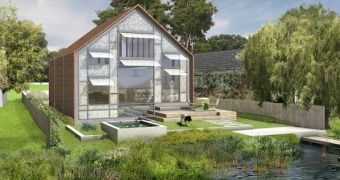Following in the footsteps of Canada, Germany, the US, Southeast Asia and Latin America, the UK decided that the time had come for it to build and test its first amphibious homes.
As their name suggests, these houses are designed in such ways that they can withstand heavy rains and floods without suffering any considerable structural damage.
The working principles are quite simple: as water levels rise, so does the house. Still, four posts driven into the ground keep the house in its place, making it behave very much like a floating pontoon, Oil Price explains.
According to the same source, the first such amphibious home on British soil was built on the banks of the River Thames by a firm known as Baca Architects.
Interestingly enough, there are some who claim that the British government's decision to support the erection of such homes is proof enough that this country's high officials are well aware of the extreme weather manifestations that might hit the UK in the not so distant future as a result of climate change and global warming.
“The floating house is secured by four dolphins (permanent vertical posts) arranged close up to the sidewalls,” Baca Architects explains.
Furthermore, “The assembly is sited within a wet dock comprising retaining walls and base slab. When flooding occurs the dock fills with water and the house rises accordingly.”
Prior to commencing work on this amphibian home, the construction engineers who participated in this project took some time to analyze the strategies employed by architects in the Netherlands when designing floating residences for people in this part of the world.
“Amphibious houses or sometimes known as 'can-float' homes are a new phenomenon in the UK.”
“As the cost of flood events start to have a more significant bearing on the public purse and the insurance secure demand higher levels of protection from the individual, flood resilient homes will become more common place,” a spokesperson for Baca Architects wished to emphasize.

 14 DAY TRIAL //
14 DAY TRIAL //